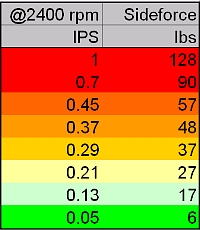The expended
energy from vibration causes wear of components, reduced performance,
passenger discomfort.

Types of imbalance
There are two types of imbalance that may be present in a propeller.
1. Mass imbalance
2. Aerodynamic imbalance
A mass
imbalance is nothing more than an imbalance in a rotating
component, normally the propeller, that is located away from center of the
rotating mass. The farther from the center of rotation, the greater the
imbalance and its destructive force.
This is the
imbalance that we aim to eliminate
or reduce dramatically.
The
following chart shows how much oscillating sideload there is at the front
crank bearing at 2400 rpm at various levels of vibration. The measure of
vibration is IPS (inches per second).

The
majority of aircraft tested have a vibration level of above .3 ips.!!
99% of
these could have this eliminated or greatly reduced.
An aerodynamic imbalance, although not
common in propeller aircraft, happens when a blade pitch variance occurs
from one blade to another during the rotational cycle. If one blade is
grabbing more air than any one of the other blades (assymetric thrust), a vibration will be
felt. This can and will occur even though any mass imbalance may have
already been corrected. This can only be fixed by adjusting,repairing or replacing the
prop. We'll detect it, though, if you have it, and achieve the very lowest vibration levels possible, throughout the highest possible RPM range .
